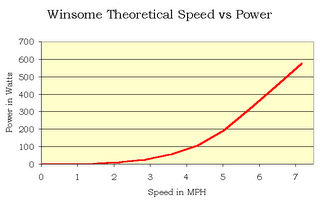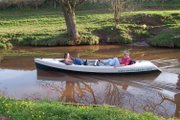
We have tried different gear ratios on Winsome during the last 18 months. The gear box itself is fixed at 1:2, but by using different sized cog wheels on the pedal units, we can change the overall ratio from about 1:6 to about 1:9. The difference this makes is interesting - especially if you don't know anything about how boat propulsion works.
The "cruising speed" of Winsome is about 4 miles an hour. You can make her go at 5.5 miles an hour if you give it a bit of welly, and a very strong crew might manage the absolute maximum of about 7 miles an hour for a short time before exhausting themselves. The interesting thing - if you've only pedalled bicycles before - is that none of these figures is determined by the gearing!
Winsome goes at her 4 mph cruising speed at 300 rpm on the propeller. The effect of the gear ratio is simply to change how fast you have to pedal and how hard you have to push to maintain that speed. This is a personal preference for the customer. The first production boat, for example, will have quite a low 1:6 ratio. This means pedalling at about 50 rpm to sustain the cruising speed of 4 mph. For most of this year, we've been using a ratio of about 1:7.5, which requires about 40 rpm on the pedals to maintain cruising speed. The first ratio we used was about 1:9, and that needed only around 33 rpm, a leisurely pace that only I seem to have liked. Obviously, the work needed to keep the boat moving at a given speed is the same, so to cruise at 33 rpm you have to push harder than you do when cruising at 50 rpm.
We have had several cyclists try the boat, and most are convinced that what she needs is a decent set of gears. While impressed with how fast she goes, they insist that with decent gears they could have achieved twice the speed that they did. And with a proper gear box, they argue, you could start with a low ratio until you get going, then change up.
We'd rather not have variable gears, because any gear changing system introduces drag, and we don't have a lot of power to play with if we want a Winsome crew to be able to talk to each other and enjoy the ride. Gear shift mechanisms also introduce cost and complexity. But the main reason we're ignoring the cyclists is that they're wrong - the boat could not be made to go any faster with gears. Gears only control how quickly you have to pedal, and how hard you have to push, to sustain a particular speed, and the range of speeds that Winsome can achieve isn't wide enough to need a higher gearing to keep pedalling rates within human capability.
The "right" gear ratio is simply the one that is optimum for the crew in terms of rate and pressure at the speed they intend to go. There is an optimum speed where the pedals feel as though they are just about keeping pace with the boat. This speed, which I have referred to as the "cruising" speed above, is just over 4 mph.
The power Winsome requires to propel her at 4 mph is probably about 200 watts. The theoretical power curve in the diagram above is for a propulsion system with no drag at all - an ideal you cannot actually achieve. This ideal power system requires only 100 watts to maintain 4.2 mph, but the power-speed curve starts to head skywards above that. So, for example, it requires double the theoretical power to achieve 5mph, and nearly 4 times the power to achieve 6mph. Winsome's so-called "hull speed" - the practical limit on the speed of any boat whose hull is immersed in the water as distinct from planing on top of it - requires 6 times the cruising power. The theoretical 600 watts required to reach hull speed translates to well over a horsepower (765 watts) in the real boat, and it would require a couple of very strong men to deliver that!
This is where boats differ from bikes. The terminal velocity of a bike - the speed beyond which you require huge amounts of power - is determined by air resistance. If you can pedal fast enough, and push hard enough, you can drive a bike to higher and higher speeds with relatively small increases in pedal speed and force. Even so, a cyclist would struggle to reach half the terminal velocity of his bike, even with 21 different gears, whereas the Winsome pedaller can reach half the terminal velocity of his machine using only one gear, literally without breaking sweat!

No comments:
Post a Comment